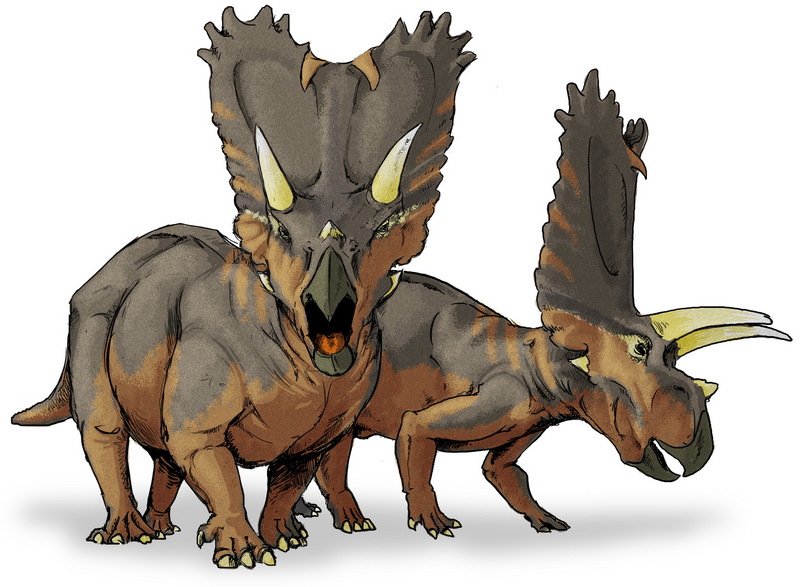Pentaceratops
From Wikipedia, the free encyclopedia
[Photo] Pentaceratops (meaning "five-horned face" and derived from Greek "penta/π??ντα" meaning 'five', "ceras/κ??ρα??" meaning 'horn' and "-ops/ωψ" meaning 'face') is a ceratopsid herbivorous dinosaur genus from the Late Cretaceous Period of what is now North America. Its name is derived from its two long epijugal bones, spikes which protrude out sidewards from under its eyes, in addition to the three more obvious horns. Date 17 juli 2007. Author LadyofHats http://commons.wikimedia.org/wiki/User:LadyofHats
Pentaceratops is a genus of ceratopsid dinosaur from the late Cretaceous Period of what is now North America. Its name means "five-horned face", derived from the Greek "penta/π??ντα" meaning 'five', "ceras/κ??ρα??" meaning 'horn' and "-ops/ωψ" meaning 'face', in reference to its two long epijugal bones, spikes which protrude out sidewards from under its eyes, in addition to the three more obvious horns.
Pentaceratops lived around 75-73 million years ago, its remains having been mostly found in the Kirtland Formation in the San Juan Basin in New Mexico. Other dinosaurs which shared its time period include Parasaurolophus cyrtocristatus, the pachycephalosaur Prenocephale, the armored dinosaur Nodocephalosaurus and possibly the tyrannosaurid Daspletosaurus.
It was about 8 m (27 ft) long, and has been estimated to have weighed around 5,500 kg (13,000 lb).
Discoveries and species
The first examples were collected by C. H. Sternberg in the San Juan Basin in New Mexico and described by Henry Fairfield Osborn in 1923, who obligingly gave it the specific name sternbergii after its discoverer. The frill of Pentaceratops is larger than that of Triceratops, with two large holes (fenestrae) in it. In 1930, Carl Wiman described a second species of Pentaceratops, P. fenestratus, but this was later determined to be the same species as the original finds. Further material discovered in Colorado has been identified as Pentaceratops in 2006.
Pentaceratops species
Pentaceratops sternbergii
Pentaceratops has the distinction of being the species which the largest known skull for a land vertebrate belongs to. That skull and its associated skeleton are on display at the Sam Noble Oklahoma Museum of Natural History. The skeleton was found in New Mexico in 1941.
Classification
Within the Ceratopsia, Pentaceratops belonged to the subfamily Ceratopsinae and appears to be most closely related to Anchiceratops and the earlier genus Chasmosaurus. It may have been a close relative to the ancestor of Torosaurus, which lived a few million years later, right at the end of the Cretaceous period, when all ceratopsians died out.
Diet
Pentaceratops, like all ceratopsians, was an herbivore. During the Cretaceous, flowering plants were "geographically limited on the landscape", and so it is likely that this dinosaur fed on the predominant plants of the era: ferns, cycads and conifers. It would have used its sharp ceratopsian beak to bite off the leaves or needles.
http://en.wikipedia.org/wiki/Pentaceratops
| The text in this page is based on the copyrighted Wikipedia article shown in above URL. It is used under the GNU Free Documentation License. You may redistribute it, verbatim or modified, providing that you comply with the terms of the GFDL. |
|

